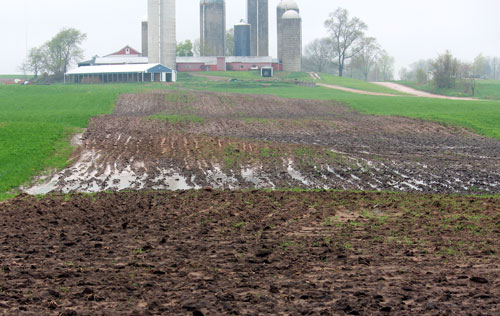West Central Michigan field crop regional report – May 15, 2014
Planting progress is at a virtual standstill in West Central Michigan.
Weather
Light rain followed by thunderstorms and heavy rains kept many growers out of the fields this week with only limited field work getting done on Sunday, May 11. Very little work has been done on the heavy loam soils, especially those without improved drainage, as they have remained too wet to work since the very beginning of the season. Many of these fields now have significant areas of standing water.
At Entrican, Michigan, air temperatures have ranged from the low 70s to low 80s for highs with nighttime lows in the low 40s to low 50s for much of the week. Low soil temperatures are in the low 50s at a 2-inch depth.
Rainfall totals have been variable with most areas receiving well over 2 inches this week.

Standing water is common in many West Michigan fields such as this one in northern Newago County. Photo credit: Fred Springborn, MSU Extension
Crops
Corn planting is 5-10 percent complete with some progress on the sands Sunday, May 11, and the following Monday morning in Montcalm and Mecosta counties. Many areas have made no progress in planting at all. No emergence has been observed yet, but the few early planted fields should be very close to spike.
Alfalfa continues to grow with most fields at 6-8 inches. Stands are generally OK through most of the region with only small areas of drown out. Few new problems have emerged and no significant alfalfa weevil feeding has been observed.
Wheat is at Feekes 5 to 6. Many fields have yet to receive their spring nitrogen application and like alfalfa most fields have OK stands with areas of drown out. Annual weed pressure is increasing of both winter and now spring annuals
We continue to capture low numbers of black cutworm moths in traps this week. Some areas may be receiving larger flights as the arrival of this pest is often scattered and un-uniform. The threat for much of the corn crop appears to be quite low at this time as most of the crop is behind in development or not even planted. It is always wise to keep an eye on your crops by scouting on a regular basis.
Other Michigan State University Extension field crop regional reports from this week:
- East Central Michigan field crop regional report – May 15, 2014
- Southwest Michigan field crop regional report – May 15, 2014
- Michigan’s Thumb area field crop regional report – May 15, 2014
- Northeast Michigan field crop regional report – May 15, 2014
- North Central Michigan field crop regional report - May 15, 2014



 Print
Print Email
Email